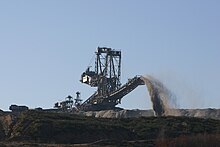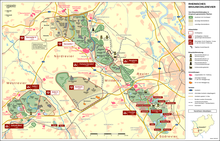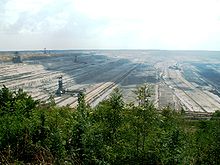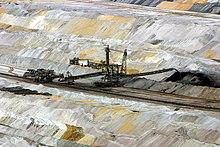Hambach opencast mine
| Hambach opencast mine | |||
|---|---|---|---|
| General information about the mine | |||
| The Hambach opencast mine seen from the neighboring Sophienhöhe | |||
| Mining technology | Open pit mine on 85 km² | ||
| Overburden | per year: 250–300 million t | ||
| Funding / year | 40 million tons | ||
| Information about the mining company | |||
| Operating company | RWE Power AG | ||
| Employees | approx. 1,500 | ||
| Start of operation | 1978 | ||
| End of operation | 2030 (planned) | ||
| Successor use | Recultivation, residual lake | ||
| Funded raw materials | |||
| Degradation of | Brown coal | ||
| Greatest depth | 400 m | ||
| Geographical location | |||
| Coordinates | 50 ° 54 '39 " N , 6 ° 30' 10" E | ||
|
|||
| local community | Niederzier, Elsdorf (Rhineland) | ||
| District ( NUTS3 ) | Düren district, Rhein-Erft district | ||
| country | State of North Rhine-Westphalia | ||
| Country | Germany | ||
| District | Rhenish lignite district | ||
The Hambach opencast mine is the largest opencast mine operated by RWE Power AG in the Rhenish lignite mining district . It affects the communities Niederzier , Düren district , and Elsdorf , Rhein-Erft district . The Hambach opencast mine is controversial due to the associated exhaust gases from coal combustion and further environmental degradation , including the clearing of the Hambach Forest . Villages over 1000 years old like Manheim have to give way to opencast mining. The mining engineer Thomas Körber has been in charge of the open pit since October 2014 .
Data
The open pit operator , then still operating under the name Rheinbraun , initiated the approval process for the open pit in 1974 and was able to start exploration in 1978. The first excavator began its work on October 16, 1978. This was accompanied by the relocation of localities and the largest forest area in the Jülich Börde , the Bürgewald - better known as the Hambacher Forest - was largely cleared. The first brown coal was mined on January 17, 1984 .
With an operating area of 4,380 hectares (2017) and an approved maximum size of the mining field of 8,500 hectares, Hambach is the largest open lignite mine in operation in Germany . According to RWE, an estimated 4,500 million tons of lignite were stored at a depth of up to 500 meters in the 1973/74 financial year. By 2011, an estimated 1,772 million tons of brown coal were still available for mining and around 40 million tons of brown coal were mined annually on this area. The lignite originated from extensive forests and moors that developed in the Lower Rhine Bay 30 to 5 million years ago. The geology of the Lower Rhine Basin is characterized by long-lasting reduction movements in the last 30 million years, to the deposition of up to 1300 m thick sedimentary package by the North Sea have passed through many rivers, which now houses up to 100 m thick lignite seams are.
At 299 m below sea level , the deepest point of the Hambach opencast mine forms the deepest artificial depression in North Rhine-Westphalia .
The open pit mines an amount of overburden of 250 to 300 million m³ annually . The ratio of overburden to coal is 6.2: 1. The extracted lignite is transported via the Hambach Railway to Bergheim - Auenheim and from there via the North-South Railway to the Niederaussem , Neurath , Frimmersdorf and Goldenberg near Hürth-Knapsack power plants transported. The overburden was z. Some of them were conveyed by belt to the Bergheim open-cast mine , which was already charred and was therefore tipped and recultivated. The hallmark of the open-cast mine, visible from afar, is the high tip Sophienhöhe , it is considered the largest artificially created mountain that towers over the flat landscape of the Börden by 200 meters.
The open-cast mining area has been expanded to the southeast since 2013. To this end, the villages of Morschenich and Manheim will be relocated. The A4 autobahn and the Hambachbahn , which is used to transport the lignite to the power plants, were relocated around three kilometers to the south, parallel to the Cologne – Aachen railway line. In addition, a small piece of federal highway 477 was relocated to the east.



In August 2020 it was announced that a well from the 2nd century could be excavated at the edge of the demolition.
Resettlement of localities
Locations that have already been relocated
- Lich-Steinstrasse
- Etzweiler
- Tanneck
- Gesolei, former settlement in the south of Elsdorf
Locations in the relocation phase
Climate-damaging emissions
The CO 2 emissions from the burning of the lignite remaining in 2019 would be mathematically sufficient to increase the natural CO 2 content of the atmosphere by around 0.7 per mille worldwide, or, together, would cause a CO 2 doubling over the entire area of Germany with 4 kg CO 2 per m 2 and one ton of CO 2 emissions per ton of lignite. This corresponds to a total of 2.4% of the CO 2 budget (9.9 billion t CO 2 ) that Germany has set itself up to 2050.
particulate matter
The Hambach opencast mine is involved in fine dust emissions in its immediate vicinity. The proportion of fine dust from the opencast mine is given by the State Office for Nature, Environment and Consumer Protection in North Rhine-Westphalia (LANUV NRW) as 25%.
For 2004, the LANUV NRW does not list a complete measurement year for exceeding the fine dust limit value of 50 µg / m³, but the permitted annual mean value of 40 µg / m³ is clearly undercut with 30 µg / m³ at the Niederzier measurement station.
Since the beginning of 2005, new limit values for fine dust emissions have been in effect across the EU. Under the leadership of the Cologne District Government, an action plan to reduce particulate matter in the vicinity of the Hambach opencast mine was drawn up, which came into force on September 29, 2005. The open-pit mine operator had already started implementing measures to reduce particulate matter in advance. In 2006, the limit value was exceeded 35 times in Niederzier, which exactly corresponded to the number of days allowed. The annual mean for this period sank to 29 µg / m³.
According to EU Directive 1999/30 / EC, from January 1, 2005 a maximum of 35 exceedances of the PM10 daily mean value of 50 µg / m³ per year are permitted. Since January 1, 2010, the daily mean value for PM10 may still be 50 µg / m³. Since 2010 the annual mean value for PM10 should only be 20 µg / m³. This has been eased again by Directive 2008/50 / EC of May 21, 2008 (Annex XI), so that from 2010 the annual mean value for PM10 40 µg / m³ will continue to apply.
According to RWE, the following measures to combat fine dust are being implemented in open-cast mining:
- Planting trees on the spoil side
- Grass growth on fallow land
- Roads are paved and conveyor belts are placed on solid ground, which reduces dust
- Sprinkling the upper level on the excavator side
- Sprinkling the north wall
- Sprinkling coal bunkers and coal belts
- when dredging, water is sprayed onto the spoil
Possible subsequent use
Open pit lake
The open-cast mine was put into operation in 1978. Every year around 0.3 cubic kilometers are moved, so that by the end of the carbonization in 2040, coal and earth with a volume of around 18.6 km³ will be mined. By April 2009, the overburden that had accrued in Hambach until then, z. Partly by conveyor belt systems in the charred Bergheim opencast mine in order to fill it up again. Now only the western edge of the opencast mine and the Sophienhöhe are tipped. The accumulation of around 1 km³ of material on the Sophienhöhe and the extracted coal creates a residual hole that should be filled with water after the mining activities have been completed.
As mining landscape a is mining lake with an area of 4200 ha, a depth of 400 m and a volume of 3.6 billion cubic meters planned. The size and volume depend on whether the Inden open-cast mine to the west, like the Bergheim open-cast mine, is backfilled with material from the Hambach open-cast mine or left open after it has been charred. Lake Hambach would then be the deepest and (in terms of volume) the second largest lake in Germany after Lake Constance . How the opencast mine should be filled is still a matter of dispute. Some voices suggest drawing water from the Rur and / or the Erft or even filling the open-cast mine with Rhine water via a pipeline . However this happens, the filling of the open pit is expected to take several decades. Completion of this artificial body of water is therefore not to be expected before the year 2100.
Floating solar park
On May 6, 2020 Meyer Burger , a manufacturer of solar cell production machines, presented its idea for a gigantic solar park in the. This would generate electricity with an output of around ten gigawatts, which roughly corresponds to the output of the coal-fired power plants Weisweiler, Neurath, Niederaussem and Frimmersdorf, which are now dependent on the opencast mines. Considerations for a later use of the gigantic area with an area of 50 square kilometers include the flooding to the lake landscape. According to Meyer Burger CEO, it would be conceivable to cover Lake Hambach with solar modules. Up to 50 million solar modules with an output of 10 gigawatts could be installed - as a floating solar park, as has already been implemented in other parts of the world. According to Uwe Rau , a major advantage of the Hambach open-cast lignite mine is that power transmission lines are already in place and can be used due to the power plants.
According to RWE Power AG, a photovoltaic project for the Sophienhöhe is conceivable.
The Minister for Economic Affairs, Innovation, Digitization and Energy of North Rhine-Westphalia, Andreas Pinkwart, also expressed support .
Storage for electrical energy
In addition to the complete flooding of the open pit, there is also the option of building a pumped storage power plant. A patent from 1995 states that such a pumped storage plant can be implemented in the Hambach opencast mine and can provide many times the pumped storage capacity currently available in Germany. With the increasing use of renewable energies , this option is gaining in importance and is being followed with interest by the mining authority.
RWE Power AG announced in May 2020 that a pumped storage plant would not be a solution, at least for the Sophienhöhe, as the construction of an Obersee would not be possible there. On the other hand, photovoltaic projects are conceivable.
There is another concept for storing electrical energy. Water is to be pumped up from the remaining hole in the opencast mine and, when electricity is required, let down past the turbines. Depending on the size of the implemented systems, storage capacities of a few 100 to a few 1000 GWh would be possible according to the concept, the storage costs should be 1 to 2 ct / kWh.
Criticism and protest
activism
2004 to 2013
At Pentecost 2004 demonstrated Greenpeace - Activists in Hambach against climate damage from lignite. They drove over the opencast mine in a hot air balloon , kept an excavator manned for several days and painted some of it pink. On May 13, 2009 the joint action by the local action group of citizens' initiatives against the relocation of the A4 and the BUND failed before the Federal Administrative Court . The plaintiffs sought the necessary for the planned expansion of the mine laying of the A 4 to stop and justified this u. a. with feared noise pollution and the possible threat to the protected Bechstein's bat and other species. The construction of the new motorway section began in 2009 and was opened to traffic in September 2014.
Since 2008, complaints about possible mountain damage in the Elsdorf-Heppendorf area have been increasing ; Since the burden of proof lies with the complainants, it is difficult to provide evidence to the miner. The newly formed lignite committee therefore decided on April 16, 2010 to set up the call center for mining damage lignite in North Rhine-Westphalia for those affected by mining damage in the Rhenish lignite district. The former president of the Hamm Higher Regional Court, Gero Debusmann , was appointed chairman of the appeal body . He is already the chairman of the arbitration board for mining damage in the coal industry . He can be called if attempts to reach an agreement with RWE Power are unsatisfactory. The procedure is free of charge for the applicant.
In November 2012 and March 2013, the police cleared tent and hut camps from open pit opponents in the remaining Hambach Forest. In 2012 a squatter had to be fetched from a six-meter-deep hiding place and in the following year two activists had to be roped off a tree platform. Later a new camp was set up at another location in the Hambach Forest.
2016
On October 23, 2016, a demonstration took place in the Hambach Forest to protect the last piece of the forest. According to the police, more than 1000 people took part, who dressed in red to form a red line on the old A4 at Buir. With the action they wanted to set an example against the deforestation of the last piece of the Hambach Forest.
2017
On November 5, 2017, one day before the start of the world climate summit in Bonn, around 3,000 activists occupied parts of the open-cast mine to draw attention to the fact that a few kilometers from the conference venue, the Rhenish lignite mining area , they say , is the largest CO 2 source in Europe .
2018
Hambach Group
The Hambach Group was an initiative founded in 1977 by young scientists from RWTH Aachen University , which dealt critically with lignite mining and its consequences; for example the buying up and demolition of localities by the opencast mine and thus the expulsion of the residents there. From 1984 to 1985 the later politician Rüdiger Sagel was the managing director of this citizens' initiative in Aachen. Their activities ended before 1990.
Action group of citizens' initiatives against the relocation of the A4 motorway

The action group of citizens 'initiatives against the relocation of the A4 motorway was an active association from 1992 to 2013 of six local citizens' initiatives from the towns of Arnoldsweiler , Buir , Manheim , Merzenich and Morschenich against the Hambach opencast mine and the relocation of the federal motorway 4 . The action group succeeded for the first time in demonstrating the enormous and irreversible environmental damage of the Hambach opencast mine in large-scale actions and thus making it clear to the affected citizens that resistance is possible. The action group has many forms of resistance - such as B. regular forest walks - invented to draw attention to the dredging of the Hambach forest .
See also
- List of German lignite opencast mines
- List of active mines in Germany, section lignite opencast mines
- Excavator 287
- Road of energy ; A 7 km long detour along the new Energy Road, which starts at the RWE Power information center at Paffendorf Castle , leads to the lookout point at Elsdorf-Angelsdorf .
literature
- Hambach Group (Ed.): Verheizte Heimat. Open pit lignite mining and its consequences . Aachen 1985, ISBN 3-924007-14-4 .
Web links
- Lignite Committee of the Cologne District Government: Composition, organizational chart. District government Cologne, May 5, 2010, accessed on August 18, 2010 .
- List of members of the Brown Coal Committee 2009 to 2014, as of March 16, 2010 (PDF; 22 kB) Cologne District Government, accessed on August 18, 2010 .
- Hambach opencast mine. (No longer available online.) RWE Power AG, archived from the original ; Retrieved January 9, 2011 .
- Hambach I. opencast mine, planned relocation of the A4, “bundling of traffic routes”, former Düren-Neuss railway line. Retrieved August 26, 2009 .
- Aerial photo of the open pit mine, Flickr. Retrieved January 9, 2011 (aerial photo of the open pit mine, Flickr).
Individual evidence
- ↑ With an agreement to phase out coal, RWE is pushing the limits of what is possible. RWE AG, January 16, 2020, accessed on January 18, 2020 .
- ↑ formerly Rheinbraun AG
- ↑ Jörg Abels: The youngest boss in the history of the Hambach opencast mine. In: aachener-zeitung.de. October 13, 2014, accessed November 8, 2017 .
- ^ RWE: Hambach opencast mine. Retrieved October 2, 2018 .
- ↑ Another 16% dividend at RWE. Power plant only leased for the first time , Abendblatt.de from January 17, 1975 (accessed on September 16, 2018)
- ↑ North Rhine-Westphalia in numbers. (PDF; 700 kB) District government Cologne, Geobasis Department NRW , February 2013, accessed on February 5, 2016 .
- ↑ Jörg Fehres: The company land consolidation - example of a successful instrument for the implementation of infrastructure measures. In: zfv Journal for Geodesy, Geoinformation and Land Management , Issue 4/2010, pp. 275-279, Augsburg 2010, ISSN 1618-8950
- ↑ https://www.bild.de/regional/koeln/koeln-aktuell/sensationsfund-uralter-brunnen-am-tagebau-hambach-ausgegraben-72315200.bild.html
- ↑ https://www1.wdr.de/nachrichten/rheinland/ausgrabung-achaeologie-tagebau-hambach-100.html
- ↑ Location of Manheim and Morschenich on the planned excavation area, as of March 22, 2010 , OpenStreetMap , accessed on March 22, 2010.
- ^ BUND: Hambach opencast lignite mine, Hambach profile. Retrieved August 13, 2019 .
- ↑ Michael Sterner , Ingo Stadler: Energy storage - requirements, technologies, integration . Berlin - Heidelberg 2014, p. 488.
- ↑ Radio Rur: Mega solar park in the open pit? Retrieved May 11, 2020 .
- ↑ Hambach opencast mine: soon a 10 GW floating solar park? In: CleanThinking.de. May 6, 2020, accessed on May 11, 2020 (German).
- ↑ Energy researcher Rau: Solar park in Hambach opencast mine possible. In: CleanThinking.de. May 11, 2020, accessed on May 11, 2020 (German).
- ^ Jörg Abels: Hambach opencast mine: Sophienhöhe remains untouched. Retrieved May 28, 2020 .
- ↑ Radio Rur: Think of the younger generation. Retrieved May 28, 2020 .
- ↑ Pumped storage plant - Patent DE 19513817 B4 , accessed on June 1, 2014.
- ↑ Hambach opencast mine: Clean energy from the coal hole , Kölner Stadtanzeiger, accessed on June 1, 2014.
- ^ Jörg Abels: Hambach opencast mine: Sophienhöhe remains untouched. Retrieved May 22, 2020 .
- ↑ The water battery in the Hambacher Loch . In: Frankfurter Allgemeine Zeitung . August 18, 2019. Retrieved August 23, 2019.
- ^ Action group of citizens 'initiatives against the relocation of the A4 motorway: Action group of citizens' initiatives against the relocation of the A4 motorway. September 19, 1992, accessed April 14, 2019 .
- ↑ Bat should stop the Autobahn. Aachener Nachrichten, February 20, 2008.
- ↑ Federal Administrative Court dismisses complaints: A4 may be relocated. Retrieved November 29, 2012 .
- ↑ Lignite Committee resolves to set up a call point for mining damage to lignite in North Rhine-Westphalia ( Memento from February 2, 2012 in the Internet Archive ), press release 036/2010 of the Cologne District Government of April 16, 2010 (PDF; 28 kB), accessed on April 25, 2010.
- ↑ "The game of hide and seek is over" , Kölner Stadtanzeiger, November 16, 2012.
- ^ Aachener Nachrichten, March 22, 2013.
- ↑ Hambach: Human chain against further deforestation , picture gallery with commentary from October 23, 2016 in Aachener Nachrichten
- ↑ Hundreds protest against further deforestation , newspaper article from October 23, 2016 in the Kölner Stadt Anzeiger, accessed on October 24, 2016.
- ↑ Patricia Hecht: Protest in front of the World Climate Conference: Multilingual in the pit . In: The daily newspaper: taz . November 5, 2017, ISSN 0931-9085 ( taz.de [accessed November 7, 2017]).
- ↑ Karin Sievers: Spatial ties in the change of urban renewal measures City, Space and Society , p. 90 + p. 95, Springer Fachmedien Wiesbaden (2015) (accessed on September 17, 2018)
- ↑ 40 years of lignite resistance , taz from May 2, 2018 (accessed on September 17, 2018)
- ↑ Biographical Rüdiger Sagel , landtag.nrw.de (accessed on September 17, 2018)
- ↑ Katrin Hater: Social learning in political discourse: A case study on the discourse on the Garzweiler II open-cast lignite mining project. 2013, pp. 97, 98 , accessed on November 8, 2017 .
- ^ Action group of citizens' initiatives against the relocation of the A4 motorway
- ↑ Hambach opencast mine and A4 relocation. May 7, 2019, accessed June 22, 2019 .
- ^ Action group of citizens' initiatives against the relocation of the A4 autobahn: Walks in the woods in the Hambach forest. March 26, 1994, Retrieved June 7, 2019 .








